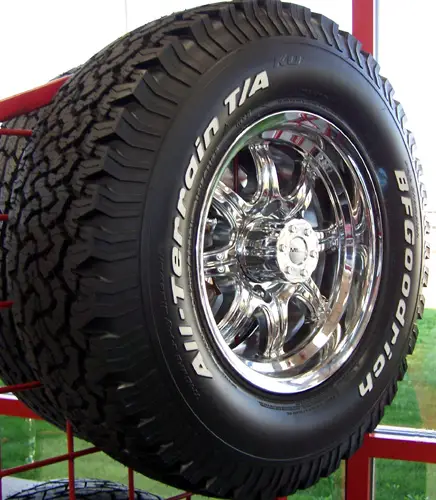Mud tires are designed for extreme off-road conditions with deep mud, while all-terrain tires provide a balanced performance on various terrains.
TL;DR Mud tires Vs. All terrain tires
Mud tires are specifically designed to excel in off-road conditions with deep mud, dirt, and slippery surfaces. They have aggressive tread patterns that provide excellent traction and self-cleaning capabilities. However, they may not perform as well on regular roads due to their noisy nature and reduced fuel efficiency.
All terrain tires strike a balance between off-road capability and everyday driving comfort. They offer decent traction on various terrains including gravel, sand, snow, and light mud while still maintaining good handling characteristics on paved roads. All terrain tires are generally quieter than mud tires but may not deliver the same level of performance in extreme off-road conditions.
What are Mud Tires?

Mud tires, as the name suggests, are specifically designed to tackle muddy and slippery terrains with ease. These off-road warriors are built with deep and aggressive tread patterns that provide excellent traction in mud, ensuring you don’t get stuck in sticky situations. The large gaps between the treads help evacuate mud quickly, preventing it from clogging up the tire.
One of the key features of mud tires is their self-cleaning ability. As you drive through muddy terrain, the rotation of your tires helps sling off any accumulated mud from the treads, maintaining optimal traction at all times.
Mud tires have reinforced sidewalls to resist punctures or damage from sharp rocks and debris commonly found on off-road trails. They also offer better grip on uneven surfaces due to their flexible construction.
However, it’s important to note that while mud tires excel in muddy conditions, they may not perform as well on other types of terrain such as dry pavement or gravel roads. Their aggressive tread pattern can create more noise and vibration when driving on regular roads compared to all terrain tires.
What are All Terrain Tires?

All Terrain Tires, also known as AT tires, are designed to provide a balance between on-road and off-road performance. These tires are versatile and can handle various terrains with ease.
One key feature of all terrain tires is their tread pattern. They typically have larger tread blocks with wider spacing compared to regular street tires. This design allows them to effectively grip both loose surfaces like gravel or sand, as well as providing good traction on paved roads.
Another important aspect of all terrain tires is their sidewall construction. They are often built with reinforced sidewalls that help protect against punctures and damage when driving over rough terrains.
Unlike mud tires which excel in extreme off-road conditions, all terrain tires offer a more comfortable and smoother ride on highways or city streets. They perform well in light snow or rain conditions due to their enhanced wet traction capabilities.
All terrain tires strike a balance between ruggedness and comfort, making them an ideal choice for those who need versatility from their vehicle’s tires – whether it’s commuting during the week or going off-roading on the weekends.
Mud tires Vs. All terrain tires – Key differences
| Aspect | Mud Tires | All-Terrain Tires |
|---|---|---|
| Tread Design | Aggressive with deep, widely spaced lugs for enhanced traction in mud and loose terrain. | Versatile tread pattern with smaller, closely spaced lugs for a balanced performance on various terrains. |
| Mud Performance | Superior performance in deep mud, offering self-cleaning ability to prevent mud buildup. | Effective in moderate mud conditions but may struggle in extremely deep or sticky mud. |
| Rock and Off-Road | Excellent for extreme off-road conditions, including rocky and challenging terrains. | Capable of handling a variety of off-road terrains, but may not excel in extreme conditions like mud tires. |
| On-Road Performance | Noisy and less smooth on paved roads due to the aggressive tread pattern. | Quieter and provides a smoother on-road ride, suitable for daily driving and highway use. |
| Snow and Sand | Limited performance on snow and sand; not designed for winter conditions. | Decent performance on snow and sand, offering better versatility for various weather conditions. |
| Tread Longevity | Tends to wear out faster on regular roads due to the softer rubber compound. | Generally has a longer tread life, making them more suitable for daily driving and extended use. |
| Driving Comfort | Less comfortable on paved surfaces; designed primarily for off-road enthusiasts. | Offers a smoother and more comfortable ride on paved roads, making them suitable for a wider range of drivers. |
| Ideal Users | Off-road enthusiasts, mudding, rock crawling, and extreme off-road adventures. | Drivers seeking a balanced tire for on-road and off-road use without extreme conditions. |
Pros and Cons of Mud Tires
Pros of Mud Tires:
Excellent Off-Road Traction: Designed with aggressive tread patterns and deep lugs, mud tires provide superior traction in challenging off-road conditions, especially in deep mud or on rocky terrains.
Self-Cleaning Ability: The spaced-out, aggressive tread design helps in self-cleaning, preventing mud and debris from getting trapped in the tire. This ensures consistent traction and performance in muddy environments.
Durability: Built with reinforced sidewalls and durable compounds, mud tires are often more robust, making them resilient to the harsh conditions encountered in off-road adventures.
Cons of Mud Tires:
On-Road Performance: Mud tires can be noisy on paved roads due to their aggressive tread pattern. The ride may also be less smooth compared to tires designed for on-road use.
Tread Wear: The soft rubber compounds that enhance off-road performance can wear out more quickly on regular roads, leading to a shorter overall lifespan compared to on-road tires.
Limited Winter Performance: While mud tires excel in mud and off-road conditions, they may not provide optimal performance in winter conditions, especially on ice and packed snow.
Pros and Cons of All Terrain Tires
Pros of All-Terrain Tires:
Versatility: All-terrain tires offer a balanced performance on various terrains, making them suitable for both on-road and off-road driving. They can handle gravel, dirt, sand, and light mud effectively.
On-Road Comfort: Compared to mud tires, all-terrain tires provide a smoother and quieter ride on paved roads. They are well-suited for daily driving and highway use, offering good comfort for extended periods.
Year-Round Performance: All-terrain tires perform well in different weather conditions, including light snow. They are suitable for drivers who encounter a variety of terrains and weather scenarios throughout the year.
Cons of All-Terrain Tires:
Specialized Performance: While all-terrain tires are versatile, they may not excel in extreme off-road conditions like mud tires. Environments such as deep mud or rocky terrain might pose challenges for all-terrain tires.
Tread Wear: Depending on the specific tread pattern, all-terrain tires may experience faster wear compared to dedicated on-road tires, especially if driven aggressively off-road.
Off-Road Limitations: While capable on a variety of terrains, all-terrain tires may struggle in more challenging off-road situations, limiting their performance in extreme conditions like rock crawling or deep mud.
Image Credits
Featured Image By – 3005398 from Pixabay
Image 1 By – Adriano Bonfim from Pixabay
Image 2 By – Larry D. Moore, CC BY-SA 4.0, via Wikimedia Commons








